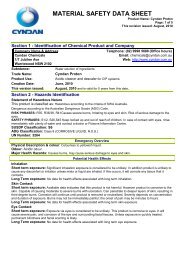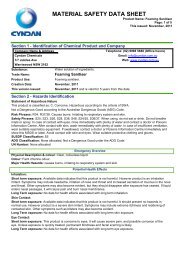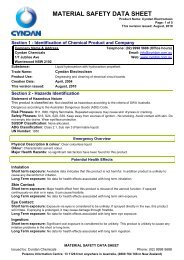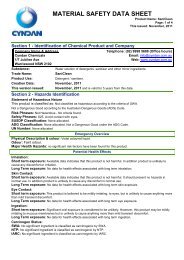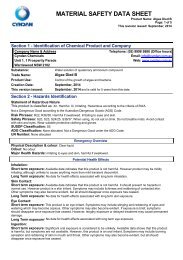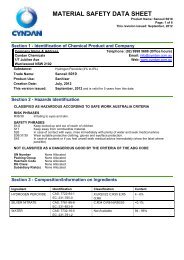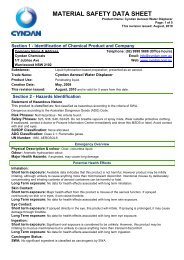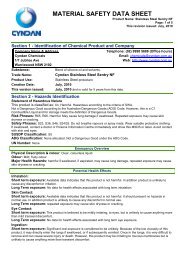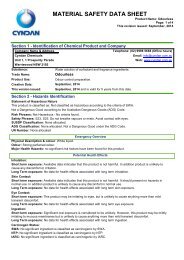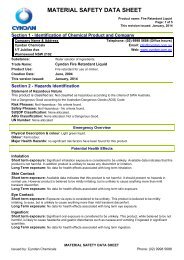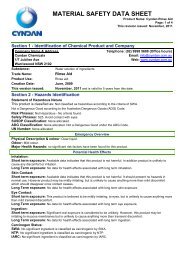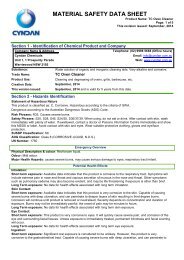Vitroglaze - MSDS - CYNDAN Chemicals
Vitroglaze - MSDS - CYNDAN Chemicals
Vitroglaze - MSDS - CYNDAN Chemicals
Create successful ePaper yourself
Turn your PDF publications into a flip-book with our unique Google optimized e-Paper software.
Product Name: <strong>Vitroglaze</strong>Page: 3 of 5This revision issued: December, 2010landfill. Ensure legality of disposal by consulting regulations prior to disposal. Thoroughly launder protective clothingbefore storage or re-use. Advise laundry of nature of contamination when sending contaminated clothing to laundry.Section 7 - Handling and StorageHandling: Keep exposure to this product to a minimum, and minimise the quantities kept in work areas. CheckSection 8 of this <strong>MSDS</strong> for details of personal protective measures, and make sure that those measures are followed.The measures detailed below under "Storage" should be followed during handling in order to minimise risks topersons using the product in the workplace. Also, avoid contact or contamination of product with incompatiblematerials listed in Section 10.Storage: Store in a cool, well ventilated area, and make sure that surrounding electrical devices and switches aresuitable. Check containers periodically for leaks. Containers should be kept closed in order to minimise contaminationand possible evaporation. Make sure that the product does not come into contact with substances listed under"Incompatibilities" in Section 10. If you keep more than 2500kg or L of Dangerous Goods of Packaging Group II, youmay be required to license the premises or notify your Dangerous Goods authority. If you have any doubts, wesuggest you contact your Dangerous Goods authority in order to clarify your obligations. Check packaging - there maybe further storage instructions on the label.Section 8 - Exposure Controls and Personal ProtectionThe following Australian Standards will provide general advice regarding safety clothing and equipment:Respiratory equipment: AS/NZS 1715, Protective Gloves: AS 2161, Industrial Clothing: AS2919, Industrial EyeProtection: AS1336 and AS/NZS 1337, Occupational Protective Footwear: AS/NZS2210.SWA Exposure Limits TWA (mg/m 3 ) STEL (mg/m 3 )Ethanol 1880 not setNo special equipment is usually needed when occasionally handling small quantities. The following instructions arefor bulk handling or where regular exposure in an occupational setting occurs without proper containment systems.Ventilation: This product should only be used where there is ventilation that is adequate to keep exposure belowthe TWA levels. If necessary, use a fan.Eye Protection: Eye protection such as protective glasses or goggles is recommended when this product is beingused.Skin Protection: The information at hand indicates that this product is not harmful and that normally no special skinprotection is necessary. However, we suggest that you routinely avoid contact with all chemical products and that youwear suitable gloves (preferably elbow-length) when skin contact is likely.Protective Material Types: We suggest that protective clothing be made from the following materials: rubber,PVC.Respirator: Usually, no respirator is necessary when using this product. However, if you have any doubts consultthe Australian Standard mentioned above.Section 9 - Physical and Chemical Properties:Physical Description & colour: Clear, colourless liquid.Odour:Mild alcohol odour.Boiling Point:81°C at 100kPaFreezing/Melting Point: No specific data. Liquid at normal temperatures.Volatiles: >80%Vapour Pressure: 0.66kpa at 20°CVapour Density:No data.Specific Gravity: 0.824Water Solubility:Completely soluble.pH:No data.Volatility:No data.Odour Threshold:No data.Evaporation Rate:No data.Coeff Oil/water distribution: No dataViscosity: 1.12mPa.s at 20°CAutoignition temp:No data.Section 10 - Stability and ReactivityReactivity: This product is unlikely to react or decompose under normal storage conditions. However, if you haveany doubts, contact the supplier for advice on shelf life properties.MATERIAL SAFETY DATA SHEETIssued by: Cyndan <strong>Chemicals</strong> Phone: (02) 9998 5688Poisons Information Centre: 13 1126 from anywhere in Australia, (0800 764 766 in New Zealand)
Product Name: <strong>Vitroglaze</strong>Page: 4 of 5This revision issued: December, 2010Conditions to Avoid: This product should be kept in a cool place, preferably below 30°C. Keep containers tightlyclosed. Containers should be kept dry. Keep containers and surrounding areas well ventilated. Keep away fromsources of sparks or ignition. Any electrical equipment in the area of this product should be flame proofed.Incompatibilities: strong acids, strong bases, oxidising agents.Fire Decomposition: Carbon dioxide, and if combustion is incomplete, carbon monoxide and smoke. Water.Carbon monoxide poisoning produces headache, weakness, nausea, dizziness, confusion, dimness of vision,disturbance of judgment, and unconsciousness followed by coma and death.Polymerisation: Polymerisation reactions are unlikely; they are not expected to occur.Section 11 - Toxicological InformationLocal Effects:Target Organs:IngredientThere is no data to hand indicating any particular target organs.Classification of Hazardous IngredientsRisk PhrasesNo ingredient mentioned in the HSIS Database is present in this product at hazardous concentrations.Section 12 - Ecological InformationThis product is biodegradable. It will not accumulate in the soil or water or cause long term problems.Section 13 - Disposal ConsiderationsDisposal: There are many pieces of legislation covering waste disposal and they differ in each state and territory, soeach user must refer to laws operating in their area. In some areas, certain wastes must be tracked. The Hierarchy ofControls seems to be common - the user should investigate: Reduce, Reuse, and Recycle and only if all else failsshould disposal be considered. Note that properties of a product may change in use, so that the following suggestionsmay not always be appropriate. The following may help you in properly addressing this matter for this product. Thisproduct may be recycled if unused, or if it has not been contaminated so as to make it unsuitable for its intended use.If it has been contaminated, it may be possible to reclaim the product by filtration, distillation or some other means. Ifneither of these options is suitable, consider controlled incineration, or landfill.Section 14 - Transport InformationADG Code: 1170, ETHANOL SOLUTIONHazchem Code: 2YESpecial Provisions: 144Limited quantities: ADG 7 specifies a Limited Quantity value of 1 L for this class of product.Dangerous Goods Class: Class 3, Flammable liquids.Packaging Group: IIPackaging Method: P001, IBC02Class 3 Flammable Liquids shall not be loaded in the same vehicle or packed in the same freight container withClasses 1 (Explosives), 2.1 (Flammable Gases where flammable liquids and flammable gases are both in bulk), 2.3(Toxic Gases), 4.2 (Spontaneously Combustible Substances), 5.1 (Oxidising Agents), 5.2 (Organic Peroxides), 6(Toxic Substances, except Flammable Liquid is nitromethane), and 7 (Radioactive Substances). They may howeverbe loaded in the same vehicle or packed in the same freight container with Classes 2.1 (Flammable Gases exceptwhere the Flammable Liquids and Flammable Gases are in bulk), 2.2 (Non-Flammable Non-Toxic Gases), 4.1(Flammable Solids), 4.3 (Dangerous When Wet Substances), 6 (Toxic Substances, except where Flammable Liquid isnitromethane), 8 (Corrosive Substances), 9 (Miscellaneous Dangerous Goods), Foodstuffs or foodstuff empties.Section 15 - Regulatory InformationAICS: All of the significant ingredients in this formulation are compliant with NICNAS regulations.Section 16 - Other InformationThis <strong>MSDS</strong> contains only safety-related information. For other data see product literature.Acronyms:ADG CodeAustralian Code for the Transport of Dangerous Goods by Road and Rail, 7th EditionAICSAustralian Inventory of Chemical SubstancesSWASafe Work Australia, formerly SWA and SWACAS numberChemical Abstracts Service Registry NumberHazchem CodeEmergency action code of numbers and letters that provide information to emergencyservices especially firefightersMATERIAL SAFETY DATA SHEETIssued by: Cyndan <strong>Chemicals</strong> Phone: (02) 9998 5688Poisons Information Centre: 13 1126 from anywhere in Australia, (0800 764 766 in New Zealand)
IARCNOSNTPR-PhraseSUSDPUN NumberInternational Agency for Research on CancerNot otherwise specifiedNational Toxicology Program (USA)Risk PhraseStandard for the Uniform Scheduling of Drugs & PoisonsUnited Nations NumberTELEPHONE (Business hours): (02) 9998 5688 Fax: (02) 9999 2086National Poisons Information Centre:Product Name: <strong>Vitroglaze</strong>Page: 5 of 5This revision issued: December, 2010Dial 13 1126 (from anywhere in Australia)THIS <strong>MSDS</strong> SUMMARISES OUR BEST KNOWLEDGE OF THE HEALTH AND SAFETY HAZARD INFORMATION OF THE PRODUCT ANDHOW TO SAFELY HANDLE AND USE THE PRODUCT IN THE WORKPLACE. EACH USER SHOULD READ THIS <strong>MSDS</strong> AND CONSIDER THEINFORMATION IN THE CONTEXT OF HOW THE PRODUCT WILL BE HANDLED AND USED IN THE WORKPLACE INCLUDING INCONJUNCTION WITH OTHER PRODUCTS. IF CLARIFICATION OR FURTHER INFORMATION IS NEEDED TO ENSURE THAT ANAPPROPRIATE RISK ASSESSMENT CAN BE MADE, THE USER SHOULD CONTACT THIS COMPANY. THE RESPONSIBILITY FORPRODUCTS SOLD IS SUBJECT TO OUR STANDARD TERMS AND CONDITIONS, A COPY OF WHICH IS SENT TO OUR CUSTOMERS ANDIS ALSO AVAILABLE ON REQUEST.Please read all labels carefully before using product.This <strong>MSDS</strong> is prepared in accord with the SWA document “National Code of Practice for the Preparation ofMaterial Safety Data Sheets” 2nd Edition [SWA:2001(2003)]Copyright © Kilford & Kilford Pty Ltd, December, 2010.http://www.kilford.com.au/ Phone (02)9251 4532MATERIAL SAFETY DATA SHEETIssued by: Cyndan <strong>Chemicals</strong> Phone: (02) 9998 5688Poisons Information Centre: 13 1126 from anywhere in Australia, (0800 764 766 in New Zealand)



